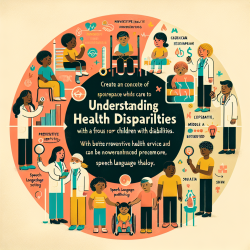Introduction
As practitioners dedicated to improving the lives of children, it's crucial to understand the unique challenges faced by children with disabilities. The study "Health Disparities Experienced by People with Disabilities in the United States: A Behavioral Risk Factor Surveillance System Study" provides valuable insights into these challenges and offers guidance on how we can better serve this population. By focusing on data-driven decisions, we can enhance the quality of care and ensure equitable access to health services for children with disabilities.
Key Findings from the Study
The study highlights significant disparities in the utilization of preventive health services among individuals with disabilities. It found that people with disabilities are more likely to experience chronic diseases, physical inactivity, obesity, and smoking. However, they are less likely to participate in certain preventive services, such as mammograms and Pap tests, compared to those without disabilities.
Interestingly, individuals with disabilities were more likely to receive flu and pneumonia vaccinations and HIV tests. This suggests that while some preventive services are accessible, others remain out of reach due to various barriers.
Implications for Practitioners
For practitioners working with children, these findings underscore the importance of advocating for accessible health services and adapting interventions to meet the needs of children with disabilities. Here are some actionable steps:
- Promote Accessibility: Ensure that your practice is equipped with accessible medical equipment and facilities. This includes adjustable examination tables and accessible dental chairs.
- Educate and Advocate: Educate parents and caregivers about the importance of preventive health services and advocate for policies that ensure equitable access for children with disabilities.
- Tailor Interventions: Develop tailored interventions that address the specific health risks and needs of children with disabilities. This includes promoting physical activity and healthy lifestyle choices.
- Collaborate with Schools: Work closely with schools to integrate health education and preventive services into the school environment, ensuring that children with disabilities receive comprehensive care.
Encouraging Further Research
While the study provides valuable insights, there is a need for further research to explore the specific barriers faced by children with disabilities in accessing health services. Practitioners are encouraged to engage in research initiatives and collaborate with academic institutions to contribute to this growing body of knowledge.
Conclusion
By understanding the health disparities faced by children with disabilities and implementing data-driven strategies, practitioners can make a significant impact on the health outcomes of this vulnerable population. Let's work together to ensure that every child, regardless of their abilities, has access to the care they deserve.
To read the original research paper, please follow this link: Health Disparities Experienced by People with Disabilities in the United States: A Behavioral Risk Factor Surveillance System Study.










